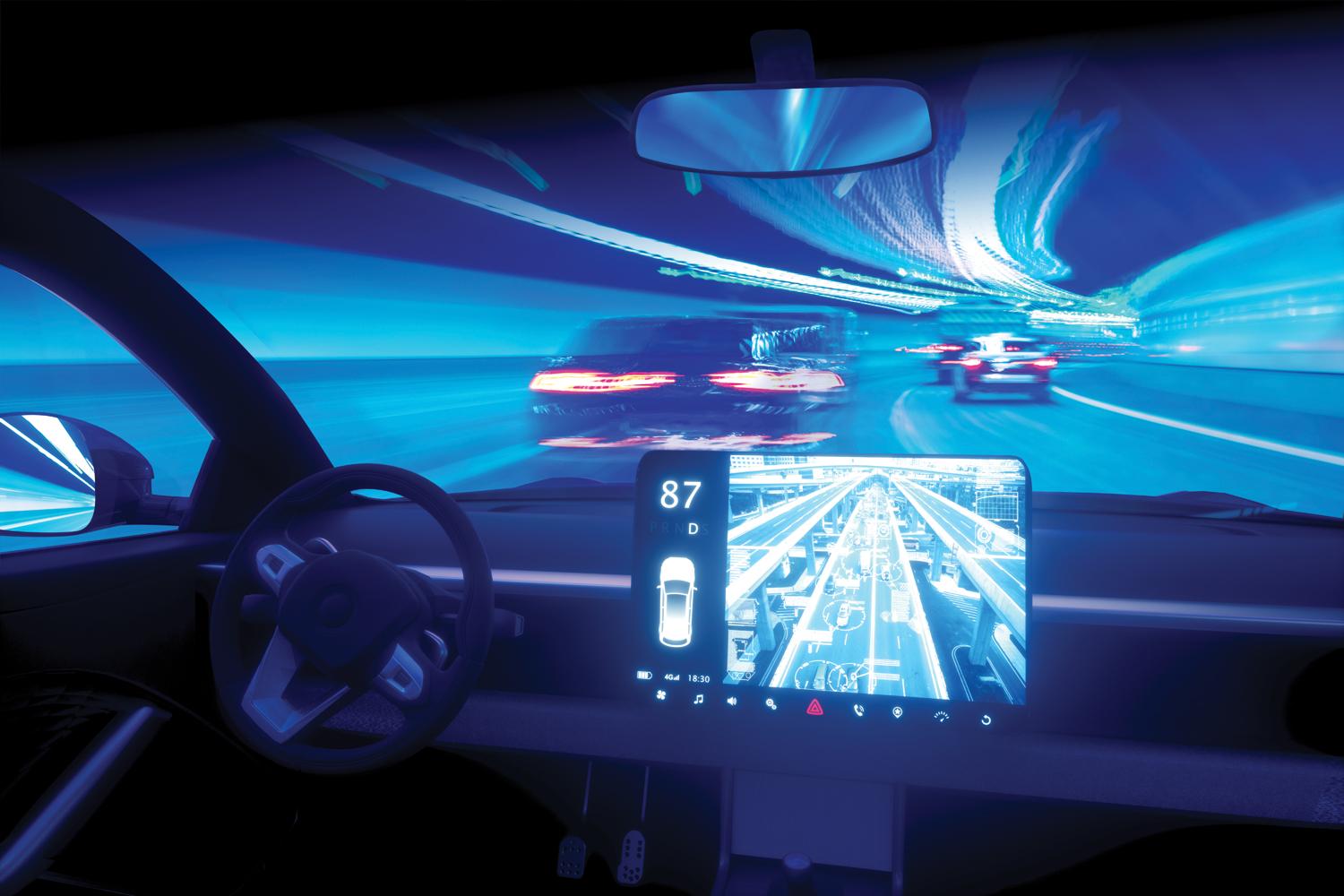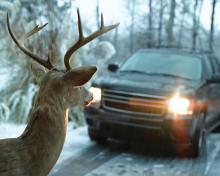- Support portal
- Evaluation Kits and partner products
u-blox Support
- Product documentation
Documentation
- Investor relations
Investor relations
Automotive's big leap
Vehicles are currently undergoing what might be their most profound transformation since they hit the mass market.

As you read these pages, the automotive sector is in the early days of a huge evolutionary leap. At its core is the collision between environmental, societal, and economic drivers on the one hand, and technological innovation on the other. Specifically, ubiquitous sensing, abundant and affordable processing power, and wireless connectivity. For the first time since mass-produced, combustion-engine-powered vehicles hit the roads, cars – once mere mechanical devices controlled by their drivers – are becoming “sentient.” Not like you and me, but still capable of sensing their environments, communicating with their surroundings, and assisting their drivers, often helping them overcome their – human – limitations. In the near future, they will take over the wheel altogether.
Contributing around 16 percent of global CO2 emissions, the road vehicle transport sector is being challenged to curtail its greenhouse gas emissions to limit the impact of climate change, with national governments driving a shift towards new propulsion systems and net-zero-carbon fuel sources. There is an expectation to increase safety on our roads, on which around 1.3 million people die in crashes each year, and up to an estimated 50 million more suffer non-fatal injuries. And to compensate for the higher component cost of today’s more sophisticated vehicles and the stagnation of global output, automakers are updating their business models to remain profitable, while private and commercial customers are changing their consumption patterns to adapt to the new normal.
This is a unique and exciting time in the automotive sector. For the first time in history, the industry has the technological toolkit it needs to rise to the occasion and meet these challenging demands. The very trends that transformed society through the internet, smartphones, constant real-time communication, and social media are now getting ready to transform every aspect of the automotive sector, too. Because of the industry’s long production cycles, the first legs of its journey – spanning the coming three to four years – have already been charted. Automotive research and development teams are busily laying the groundwork for the vehicles that we’ll see on our roads by the end of the decade. But where this ongoing evolutionary leap will take us over the course of the coming decades is anyone’s guess.
New propulsion systems and fuel sources
Amidst the uncertainty, one thing is clear: with regulations on CO2 emissions beginning to show their teeth, the heyday of fossil-fuel-powered vehicles is over. Norway’s ban on sales of new ICE (internal combustion engine) vehicles will take effect in 2025. Ireland, Iceland, and Denmark will no longer sell fully fossil-fuel-powered cars as of 2030. And, starting in 2035, China, the world’s largest automotive market, will follow, banning the sale of standard ICE vehicles and limiting the sale of hybrids to 50 percent. Meanwhile, Volkswagen will phase out the development of fossil-fuel-powered vehicle platforms by 2026, with investments of US$ 80 billion to transition to electronic vehicles (EVs). Jaguar will become all-electric by 2025, with Bentley and Volvo among those to follow by 2030, and GM by 2035.
The very trends that transformed society through the internet, smartphones, constant real-time communication, and social media are now getting ready to transform every aspect of the automotive sector, too.
According to a survey by the World Economic Forum and McKinsey, consumer sentiment is evolving too. During the first year of the COVID-19 pandemic, the appreciation of automotive OEMs by consumers improved around the world. In Asia, the share of respondents that viewed them positively went up by 12 percent. In North America and Europe, it increased by 7 percent. At the same time, 83 percent of North American and Asian respondents reported an increased interest in purchasing an EV, while in Europe, where opinions were already very positive prior to the pandemic, two-thirds reported that their interest had either stayed the same or increased.
Despite clear indications of a shifting tide, fossil-fuel-powered vehicles will stick around for some time, and not only due to their lower cost. Cars have an average lifespan of over 11 years. Semi-trucks can average around 15 to 16 years. So, even if new sales of plug-in hybrids and battery-powered electric vehicles grow to over 25 percent by 2029, as ABI Research anticipates, it will take much longer for them to outnumber ICE vehicles on our streets.
In the interim, ancillary services and infrastructure will be given time to adjust. Auto workshops will be hit by reduced demand, as electric motors, which have far fewer parts and do not need oil changes, require less maintenance than ICE vehicles. Unlike gasoline, electricity is available more or less everywhere. As a result, gas stations will be forced to charge their offering to meet the needs of the new vehicle fleet and grow the network of EV charging points. And homes, commercial buildings, and offices will see the need to install charging points to meet increasing demand.
Fuel cells, which produce electricity by letting hydrogen and oxygen react, offer an alternative way to power EVs. Like today’s fossil-fuel-powered fleet, fuel cell electric vehicles (FCEVs) need to go to dedicated charging stations to top up their hydrogen tanks. But while standard vehicles emit a cocktail of noxious gases, FCEVs simply emit water. With roughly the same drive train as any electric vehicle, FCEVs can outperform EVs in terms of range without putting on too much weight: hydrogen offers 120 megajoules per kilogram compared to around 5 megajoules per kilogram for batteries. While the US foresees a vast expansion of FCEV-powered commercial vehicles, Japan, Korea, China, and Europe have set ambitious targets for passenger vehicles as well.

Finally, synthetic fuels may offer a way to leverage the existing distribution infrastructure for gasoline and diesel, while eliminating their environmentally harmful side effects. Porsche is only the latest of many automakers investigating the development of synthetic fuels, which have the potential to make existing vehicles as “green” as electric ones, with no required changes to the engine. The fuel they are trialing will be made by using renewable energy to combine CO2 and hydrogen to create a combustible liquid very similar to today’s fuels. But while fossil fuels introduce carbon sequestered underground for millions of years back into the atmosphere, the synthetic fuels proposed by Porsche and other automakers use CO2 that is already in circulation.
Assisted and autonomous driving
Automakers have consistently worked to increase the safety of their vehicles, often egged on by legal mandates. Windscreen wipers, seat belts, and airbags, as well as different forms of assistance, such as ABS, parking cameras, and blind-spot warnings, are among the features that have been added over the years. Now, the technological triumvirate that brought us the Internet of Things – ubiquitous sensing, cheap and abundant processing power, and wireless connectivity – is raising assisted and autonomous driving to new heights, transforming cars and other vehicles into active agents capable of contributing to increasing road safety, and, frankly, making us better drivers.
While all highly assisted and autonomous vehicles share the need to be able to sense their surroundings, there are about as many sensor setups dedicated to perceiving the environment as there are automakers, drawing on a diverse set of sensing technologies. Bluetooth, for instance, can be used to detect and authenticate an approaching driver and unlock the vehicle’s doors. While parked, a GNSS (global navigation satellite system) receiver can retrieve the last stored position or, if outdoors, proceed to get a new position fix and feed that to the in-vehicle navigation system. Ultrasound or millimeter band radar can detect low-lying obstacles surrounding the car and, in collaboration with cameras with an increased field of view, help the vehicle leave the parking space and engage into traffic. And once on the road, a combination of cameras, radars, and lidars can continuously gather information about surrounding traffic signs, obstacles, and other traffic participants. All the while, a complementary set of connected sensors will be monitoring the vehicle’s performance as well as the driver’s preparedness to take over the wheel when necessary.
Wireless communication extends the vehicle’s sensors beyond its own boundaries. With vehicle-to-everything (V2X) communication, based either on short-range (DSRC) or cellular technology (C-V2X), vehicles will be able to exchange information amongst themselves to negotiate complex maneuvers such as lane merging, overtaking, or managing four-way stop signs. It can be used to deliver vehicles real-time information of nearby traffic signs, the status of traffic lights, and alerts when vulnerable traffic participants such as cyclists or pedestrians are present. The technology is even being designed to allow the vehicle to access other vehicles’ cameras and sensors in what is referred to as collective perception, for example, to better assess the safety of planned maneuvers.
Finally, the communications will extend up into the cloud, connecting the vehicle with a variety of added-value services and features. This will allow them to download always-up-to-date high-definition (HD) maps of their surroundings required to make sense of their environment, localize themselves in space, and inform them of any obstacles in their route. Together with satellite-based positioning, HD maps will be essential to authorize autonomous driving features in designated areas in highly but not fully autonomous vehicles. And the data pipe to the cloud will also let car manufacturers stay in touch with their vehicles post-sale to track their performance, detect any signs of deterioration before they cause harm, and enhance their functionality.

Processing the wealth of the data gathered by in-vehicle sensors and incoming wireless communication and translating it into actions requires a high-performance computing platform designed for image recognition, path mapping, and performance optimization, as well as an advanced human-machine interface. Companies like NVIDIA have developed dedicated supercomputing platforms that leverage AI to offer the compute power highly automated and autonomous vehicles will need. Panasonic, meanwhile, recently presented an advanced augmented reality heads-up display (AR HUD) that it expects to see deployed in vehicles as soon as 2024. The HUD presents relevant information, such as navigation guidance, advanced collision warnings, traffic information, and more by projecting it into the driver’s field of view.
At the time of writing, the very first commercial vehicles are transitioning from offering advanced driver assistance (ADAS) – in which the driver always needs to remain at the wheel (referred to as Levels 1 and 2) – to automated driving (AD) – in which the driver can relinquish control in well-defined scenarios of increasing scope (referred to as Levels 3 and 4). The Honda Legend, available as a limited edition in Japan, enables Level 3 autonomous driving in traffic jams. The path to full autonomy – all the time, everywhere (Level 5) – will be a cautious, incremental journey that will still take years to unfold. Getting there safely will depend on being able to manage the various levels of risk involved, from sensor and connectivity performance outages to sensor jamming, spoofing, and other cybersecurity threats.
Back to the drawing board
Developing business models that enable scaling up production will likely require as much ingenuity as developing the connected vehicles themselves. As with electrification, Tesla, based out of Silicon Valley in the US, has been setting the pace of innovation while selling its vehicles to the mass market, demonstrating what can be done. Building on talent from the nearby Big Tech industry, the company designed its vehicles from scratch around their ability to sense, process, and act on data. This has forced established automakers, many of which were already playing catchup in the electrification arena, to fundamentally rethink their vehicle platforms and ramp up investment in software development as well. Ultimately, it is leading to a return to the drawing board – a radical redesign of the car’s hardware and software architecture.
One approach that automakers are adopting to bring down the hardware cost of electric vehicles is by embracing a modular vehicle design comprising elements that can be reused across their entire portfolio. The Renault-Nissan-Mitsubishi alliance, for example, has developed its CMF-EV (Common Module Family – Electric Vehicle) platform, upon which it intends to build several of its upcoming electric cars. Daimler-Mercedes’s EVA platform for EVs, Volkswagen’s Modular Electric Drive (MEB) Matrix, and GM’s Ultium platform are just some other examples. Not only does concentrating research and development as well as manufacturing on a modular hardware architecture undergirding a variety of models help automakers lower costs by achieving benefits of scale; it also lets them optimize the performance of their vehicles.
The communications will extend up into the cloud, connecting the vehicle with a variety of added-value services and features.
As more and more of the functionality of our vehicles is controlled by computers, their computational architecture is evolving as well. Most advanced cars have more than one hundred electronic control units (ECUs), each dedicated to a particular task, such as controlling the powertrain, the suspensions, or the brakes. These can be organized in a way that increases their ability to collaboratively implement more complex functions.
Going forward, there will be a push to consolidate the computational power into a small set of function-specific domains before, ultimately, running the entire automotive stack on a single, high-performance computational unit that will host the function-specific systems on virtual domains. This transition will be paralleled by an increasing separation between the hardware required to implement a functionality and the software required to control it, with the vehicles becoming less and less defined by the hardware that they are made up of, and more and more by the software and applications that they run.
This shift from horsepower to petaflops, and from classy leather upholstery to software-powered augmented reality presents a particular challenge to established automakers for whom the IT and service mindset are not yet ingrained in their DNA. Whereas new joiners such as Tesla may have been optimally prepared for these demands, incumbents in Detroit, Munich, or Seoul are having to catch up by investing massively in partnering with software development capacities, acquiring them, or building them from the ground up. That isn’t to say that they are lagging far behind. According to a report by Deloitte, BMW and Mercedes expect to have centralized electronic and electrical architectures in their vehicles in 2021, resp. 2024.
The first step in a long journey
The confluence of environmental, societal, and economic drivers with new enabling technologies in sensing, data processing, and wireless communication is reshuffling the automotive sector across all major markets. Established car OEMs are making massive investments to secure their leadership position into the future as emerging players based predominantly on the US West Coast, but also in China, demonstrate the value of designing cars around software, sensing, services, and data. As the automotive industry and its suppliers adjust to these momentous changes in drivetrain technology, vehicle automation, hardware and software architecture, and business models, it’s worth remembering that this is but the first step of a long journey.

Stay informed
We would like to keep you informed.
Fill out this form to stay up to date with new ideas and emerging technology from u‑blox.



